Ligament Rupture
What are Knee Ligament Ruptures?
Knee Ligaments comprise elastic tissues that interconnect bones to one another. They bind the joint together, providing stability and support to the joint.
The ligaments protect the knee joint from abnormal movement and stabilise the joint during movement.
The ligament may partially or completely snap or tear when stretched beyond its limits.
Risk Factors for Ligament Rupture
While ligament injuries can affect anyone, some groups are more susceptible:
- Athletes: Sports that involve sudden changes in direction, high-impact movements, or contact, such as football, basketball, and soccer, pose a higher risk of ligament rupture.
- Age: As we age, the integrity of our ligaments may diminish, making older individuals more prone to ligament injuries.
- Previous Injuries: Those with a history of ligament injuries are at greater risk of recurrent ruptures, as weakened ligaments may be more susceptible to future damage.
- Genetics: Some individuals may have genetic predispositions that make their ligaments less robust, increasing their vulnerability to ruptures.
Causes of Ligament Rupture
Several factors can lead to ligament injuries:
- Trauma: A sudden, forceful impact or excessive stress on a joint can cause ligament rupture. This often occurs during sports-related injuries, accidents, or falls.
- Overuse: Repetitive movements or overuse of a joint can gradually weaken ligaments, making them more susceptible to rupture. This is common in repetitive activities, such as running or jumping.
- Poor Conditioning: Weak muscles and inadequate conditioning can contribute to ligament injuries. Strong muscles help support and protect ligaments, reducing the risk of rupture.
- Improper Technique: Using incorrect techniques or body mechanics during physical activities can place undue stress on ligaments, increasing the likelihood of injury.
Symptoms of Ligament Rupture
The specific symptoms can vary depending on the location and severity of the injury but may include:
- Sharp or intense pain at the site of the injury is a common symptom of ligament rupture.
- Swelling around the affected joint is a typical response to injury and inflammation.
- A feeling of joint instability or giving way, especially during weight-bearing activities.
- Discoloration or bruising may develop around the injured area due to damaged blood vessels.
- Difficulty moving the joint through its full range of motion due to pain and stiffness.
- Some individuals report hearing or feeling a popping or snapping sensation at the time of injury.
Types of Ligament Rupture
ACL Rupture
The Anterior Cruciate Ligament (ACL) is a tough band of elastic connective tissue that runs diagonally through the centre of your knee. The ACL provides stability, particularly during pivoting, twisting and fast-paced movements and prevents the tibia from sliding out in front of the femur. ACL ruptures are one of the most common knee injuries and usually result from a non-contact twisting injury. Although, they can also occur due to a collision or contact injury.
PCL Rupture
The Posterior Cruciate Ligament (PCL) is one of the four major ligaments connecting the femur to the tibia. It is located within the back of the knee and is larger and thicker than the ACL, requiring larger forces to cause injury.
The PCL is usually injured by direct impact. Common causes include falling onto a bent knee, sporting injuries and motor vehicle accidents. Injury to this ligament is common compared to ACL rupture.
MCL Rupture
The Medial Collateral Ligament (MCL) is located on the inner aspect of the knee, connecting the femur to the tibia, and controls sideways movement. A common knee injury, MCL rupture, occurs when the knee is forced inwards into an excessive ‘knocked knee’ position. MCL injuries are common in various sports, especially soccer, AFL, netball, rugby, netball and basketball.
Grade of Ligament Rupture
Injuries to ligaments can be graded depending on the severity of the injury.
- Grade I: the ligament is mildly damaged and slightly stretched, but the knee joint is stable.
- Grade II: the ligament has been stretched to a point where it becomes loose and has a partial tear.
- Grade III: the ligament has been torn or directly pulled off the bone, and there is a complete tear resulting in an unstable knee joint.
Diagnosis of Knee Ligament Rupture
Ligament injuries are usually suspected following a comprehensive clinical history examination and physical examination of manipulating the knee and leg bones. Diagnosis is confirmed with imaging. An MRI will show any damage to the injured ligament or surrounding soft tissue structures in the knee (including other ligaments, cartilage, menisci and bone). X-rays may also be requested to rule out other problems in the knee with similar symptoms or if the injury is associated with a fracture.
Treatment for Knee Ligament Rupture
Non Operative Treatment
Immediately following a knee injury before being evaluated by a doctor, you can initiate the R.I.C.E. method of treatment:
- Rest: Rest the knee, as more damage could result from pressure on the injury
- Ice: Ice packs can be applied to the injured area to reduce swelling and pain. Never place ice directly over the skin. Ice should be wrapped in a towel and applied to the affected area for 15-20 minutes four times a day for several days.
- Compression: Wrapping the knee with an elastic bandage or compression stocking can help minimise the swelling and support your knee
- Elevation: Elevating the knee above the heart level will also help reduce swelling and pain.
It is important to seek your doctor’s advice if you hear a popping noise or feel your knee has given way at the time of injury and if you cannot move your knee because of severe pain.
Surgery
Suppose the collateral ligament is torn in a way that can not be healed (for example, high-grade injuries) or is associated with other ligament injuries. In that case, surgery may be suggested to repair it.
Where non-surgical therapies have been exhausted, your doctor may discuss surgical solutions such as a Knee Ligaments Reconstruction for the ACL or PCL Reconstruction Surgery.





